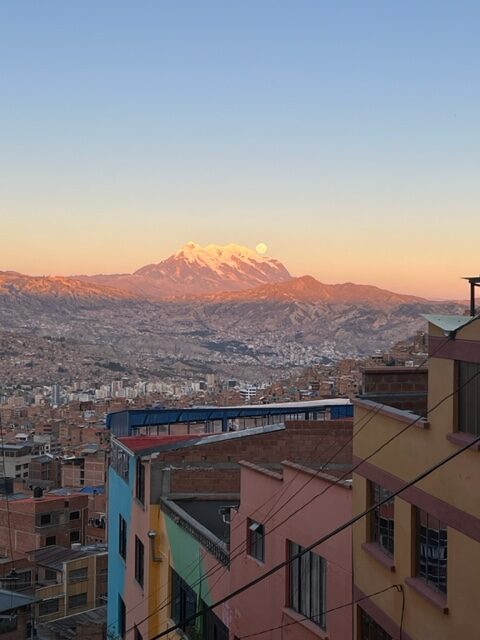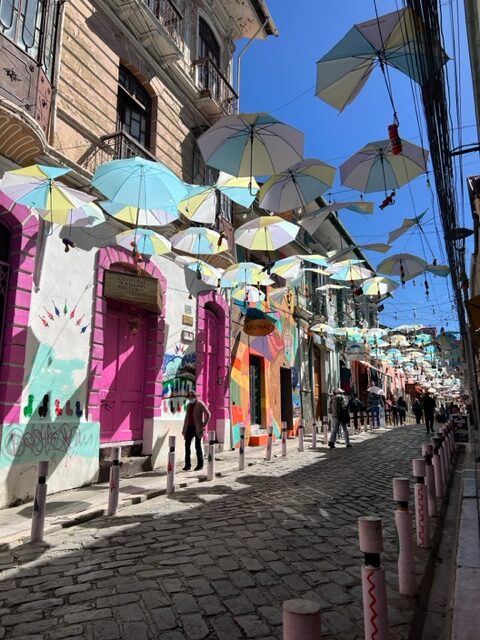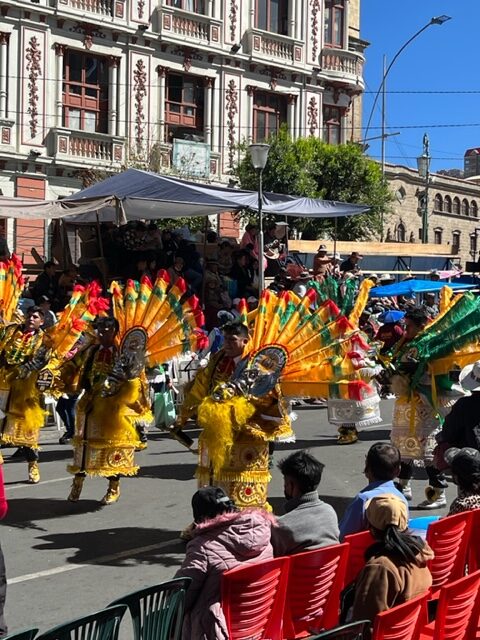





La Paz is the gateway to Bolivia. With flights to El Alto International Airport, the city serves as a convenient starting point to exploring the country’s diverse landscapes and cultural heritage.
La Paz is the “highest administrative capital” in the world, at an elevation of 11,975 ft above sea level.
What does that mean? Although Sucre is Bolivia’s constitutional capital, La Paz serves as the country’s administrative and political capital. Not only does the Bolivian government operate from La Paz, it is home to the presidential palace, government offices, and foreign embassies.
La Paz may be located in a valley, but even so, there are hills within every neighborhood. Wear comfortable shoes and anticipate a workout just walking around.
2/3 of the population are Indigenous people. There are a total of 36 recognized indigenous peoples, recognized by the Wiphala flag (rainbow squares). Here especially, it’s important to show respect for indigenous culture and traditions.
The city is very photogenic but be aware when taking photos, locals may feel uncomfortable or consider it disrespectful to have their picture taken without consent.
There’s not a lot of green space. The squares, or plazas, are usually pavement or concrete based.
The narrow streets are often bustling with activity, including street vendors selling local crafts, food, and traditional products. The stalls are all sell similar products in certain areas for advertising purposes. It also builds a community.
The downtown area of La Paz features a mix of colonial architecture and modern buildings.
The central prison, or San Pedro Prison, is one of the most interesting buildings. It is known for its distinct self-contained community within its walls. Inmates and their families live inside the prison, creating a unique society with its own economy, shops, restaurants, and even businesses run by inmates. With only perimeter guards, inmates are responsible for maintaining order and security within the prison.
The reason you might have heard of San Pedro Prison is because it gained fame for offering guided tours conducted by inmates themselves. No longer allowed, you can check out the book “Marching Powder” by Rusty Young for an insider look instead.
The street lights don’t necessarily correspond with what the cars do. Run for the other side when you can!
In Bolivia, colors represent life. And the city does not lack color.
The Witches’ Market, also known as Mercado de las Brujas, is a famous market in La Paz where you can find a variety of unusual items like dried llama fetuses, herbs, potions, and traditional Andean remedies.
Unfortunately The Witches’ Market has gotten touristy and has become more of a stop for souvenirs in Bolivia. The REAL Witches’ Market is in El Alto. Take this Red Cap tour to learn more and maybe even have your fortune read.
Bolivians love rituals, such as blessing homes and businesses (this is why you see the lamb fetuses).
Pachamama, or Mother Earth, is the highest divinity of the Andean people. She represents fertility, generosity, ripening crops and protection. Expect a few drops of any given beverage to go to Pachamama first.
Coca leaves aren’t just for altitude sick tourists. The locals enjoy the tea and taste, and more than that, the leaves play a central role in rituals, ceremonies, and traditional practices.
Coca leaves are used by traditional healers and shamans in divination practices, spiritual offerings, and communication with the spiritual realm. They are often shared among community members as a symbol of friendship, hospitality, and unity.
La Paz is known for its extensive cable car system, called the Mi Teleférico, which is the world’s longest urban cable car network. It provides a clean, safe and convenient mode of transportation, not to mention the panoramic views of the city and surrounding mountains.
La Paz is the birthplace of Cholitas Wrestling, a unique form of entertainment where indigenous women, known as cholitas, participate in wrestling matches. If you’re going to sign up for this show, go on Sunday when the locals are there!
Beyond the city limits, La Paz offers access to stunning natural landscapes and outdoor adventures. The nearby Andes Mountains provide opportunities for hiking, trekking, and mountaineering. For those adrenaline enthusiasts, try biking Death Road “Camino de la muerte” or hiking the picturesque, but demanding, Huayna Potosi!
La Paz is just the starting point. From here, head to Uyuni Salt Flats, Lake Titicaca or Rurrenabaque rainforests.
